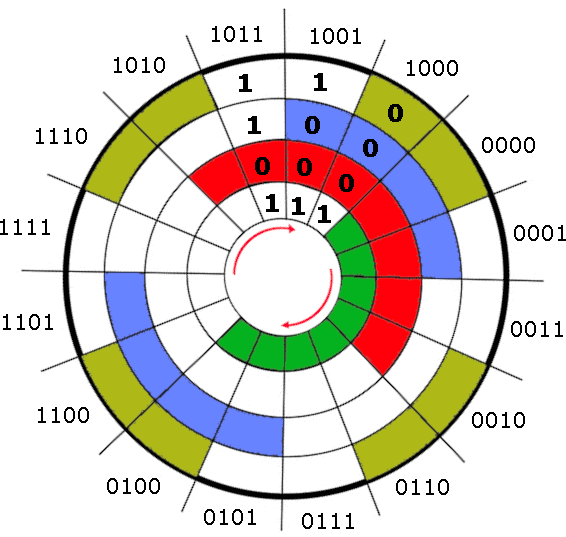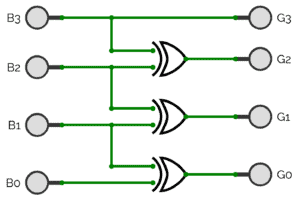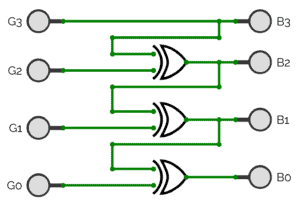Learn through the super-clean Baeldung Pro experience:
>> Membership and Baeldung Pro.
No ads, dark-mode and 6 months free of IntelliJ Idea Ultimate to start with.
Last updated: May 25, 2024
The natural binary representation assigns each binary digit a value of 0 or 1 based on powers of 2, allowing for straightforward arithmetic and logic operations. Essentially, it’s the mathematical representation of base-2 numbers. However, this representation faces challenges that the Gray code can address.
In this tutorial, we’ll explore the differences between Gray code and natural binary representation.
In the early 20th century, mechanical and electromechanical systems, such as rotating machinery and switches, were prone to errors during state transitions. These errors occurred because the natural binary representation could cause multiple bits to change simultaneously, resulting in ambiguous or incorrect readings.
For example, in natural binary, the transition from 0111 (7) to 1000 (8) involves changing all four bits simultaneously, increasing the likelihood of misreading intermediate states. If an error occurs during this transition, the resulting value could be far from the intended value, making error detection and correction very complex.
Frank Gray’s 1947 introduction of Gray code addresses this problem by ensuring that only a bit changes during transitions between successive values. This single-bit change property reduces the potential for error, making Gray code particularly useful in applications where precise and reliable state changes are critical.
Another important motivation for Gray code is its potential to simplify error detection and correction in digital communication systems.
Let denote the set of all binary strings of length
, where
. A Gray code of order
is a sequence
of elements in
such that every successive pair
of bitstrings differs by exactly one bit.
Here are its key features:
Let’s look at two examples of Gray code sequences:
Gray code is also known as reflected binary code (RBC).
A notable early application was Gray code rotary encoders, which are still in use today. These devices convert the angular position or motion of a shaft or axis into digital output signals.
Here is an example of a 4-bit encoder that can measure 16 positions, each represented by a 4-bit Gray code. It consists of concentric circles, where each ring represents a different bit in the 4-bit code, starting from the innermost ring (most significant bit, MSB) to the outermost ring (least significant bit, LSB). The color-coded cells represent bit 0, while the white cells represent ones:

This encoder demonstrates a complete (clockwise) cycle from 0000 (0) to 1000 (15), highlighting the cyclic nature of Gray code. Each number differs from its predecessor in a single bit, unlike in the natural binary representation:
| Position | Gray code | Natural binary |
|---|---|---|
| 0 | 0000 | 0000 |
| 1 | 0001 | 0001 |
| 2 | 0011 | 0010 |
| 3 | 0010 | 0011 |
| 4 | 0110 | 0100 |
| 5 | 0111 | 0101 |
| 6 | 0101 | 0110 |
| 7 | 0100 | 0111 |
| 8 | 1100 | 1000 |
| 9 | 1101 | 1001 |
| 10 | 1111 | 1010 |
| 11 | 1110 | 1011 |
| 12 | 1010 | 1100 |
| 13 | 1011 | 1101 |
| 14 | 1001 | 1110 |
| 15 | 1000 | 1111 |
Gray code’s single-bit change property minimizes error risk, leading to its widespread adoption in various electromechanical systems.
Before we continue, we need to know how to convert a number from base 10 to base 2 and what the XOR logic gate is.
We can convert a binary number to a Gray code number
using this functional relationship:
We can implement it with a logic circuit. Here’s how it looks for 4-bit numbers:
 For example, let’s consider the 4-bit binary number
For example, let’s consider the 4-bit binary number :
Thus, 1010 in binary converts to 1111 in Gray code.
We can convert a Gray code number to a binary number
as follows:
Here’s how a circuit can do the conversion of four bits:
 For example, let’s consider the 4-bit Gray code number
For example, let’s consider the 4-bit Gray code number :
It maps to 1010 in binary.
To better understand the differences between Gray code and natural binary code, here is a table comparing their properties in some practical applications:
| Feature | Gray Code Advantage | Natural Binary Issue |
|---|---|---|
| Error Rate | Low due to single-bit transitions | High, as multiple bits may change simultaneously |
| Application in rotary encoders | High precision and reliability in position encoding | Prone to errors in fast or complex mechanical settings |
| Usage in analog to digital converters (ADCs) | Accurate analog to digital conversions | Increased potential for sampling errors |
| Robustness in digital communication | Improved signal integrity, especially under noisy conditions | Susceptibility to errors increases with noise and signal degradation |
| Implementation complexity | Simplifies circuit design for error checking and correction | Complex circuitry needed to manage and correct multiple bit changes |
| Implementation in visual display units (digital clocks, public information displays, etc.) | Consistent and error-free transitions ensure reliable data display | Possibility of flickering or incorrect display during transitions |
| Quantum computing | Potential for error reduction in qubit representation and manipulation | Less suitable due to high sensitivity to state changes |
These advanced applications illustrate the broad utility of Gray code and demonstrate its potential in cutting-edge technology sectors.
In this article, we explored the basic concepts and practical applications of Gray code. The main difference between Gray code and natural binary representation is how they handle sequential numbers.
In natural binary representation, multiple bits can change simultaneously between two successive numbers, potentially causing errors in digital systems. In contrast, Gray code is designed so only a single bit changes between successive values, reducing the risk of errors during transitions.